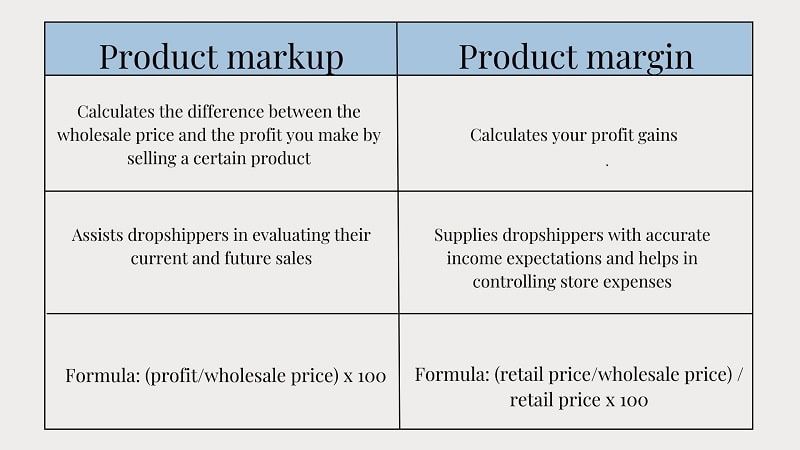
Marketing
Why are reviews important for your retail store?
Reviews guide customers as they make choices, foster trust, and can even give sales a significant lift. If your clothing...
Markup vs. Margin: How to Differentiate Between Them?
Dropshipping

One of the unspoken rules in business calls for always staying on top of your expenses and constantly regulating your products' prices and keeping an eye on online price competitors. After all, if you don’t closely monitor the financial situation of your dropshipping business, you expose yourself to great risks and inconveniences that can easily lead to your store’s doom. In order to avoid undergoing such issues, it’s crucial to make time to establish the markup and margin of your products, taking into account the fact that they play a significant role in controlling your dropshipping store’s current and future incomes and helping you in increasing your sales.
Despite being used with a similar purpose, the product markup and margin are two completely different business measurements many entrepreneurs, especially beginners in retail, often mix up and can’t get a grasp on what is what.
In order to put an end to all of that confusion, we’ve taken the initiative to create a comparison of these two terms that’ll assist you in clearly distinguishing between them. In the following paragraphs, you’ll have the opportunity to read about comprehensive definitions, learn about calculating methods, and inform yourself about the importance of setting up the markups and margins of your merchandise.
A product markup refers to the difference between the price your wholesale supplier charges you for a certain product, which is also called the wholesale price, and the profit you’ll make when selling that product to your customers. By calculating the markup of the items in your store, you’re constantly informed about the exact amount of revenue you’re generating, thus allowing you to control your expenses in a very efficient manner.
Although at first it may seem like a complicated task, calculating the markup of your products can be done by implementing quite a simple formula:
Product markup = (Profit/Wholesale price) x 100
To provide you with a more elaborate clarification, let’s put the formula into action. To illustrate, assume you’ve launched an online clothing dropshipping store specializing in selling high-end apparel pieces from worldwide renowned brands. Your supplier, BrandsGateway, one of the most prominent B2B companies in luxury fashion, enables you to add markup for all categories you’ve imported in your store.
As an example, let’s calculate the product markup of the following leather Michael Kors handbag. A customer has purchased the bag, and the order has been automatically redirected to BrandsGateway, charging you a wholesale price of €96. The recommended selling price, nevertheless, is €448. By deducting the wholesale from the retail price, you’re left with a revenue of €352. Then, we divide the profit with the retail price, multiply it by 100, and get a product markup of 78%.
Calculating your product markup is a prominent business step you shouldn’t avoid skipping. This is because by knowing the markup of the merchandise you’re selling, you’ll be capable of understanding where you stand with your business growth and accurately assessing your profitability in future sales.
For instance, selling luxury fashion goods, like the one discussed in the example above, is considered to be a high-earning business that brings stores significant revenues in comparison when working with other market sections. Nevertheless, the competition here is fierce, leaving many businesses struggling to come up on the surface. By knowing your product markups and modifying them when needed, you’ll save your store from experiencing a decrease in both customers and sales.
The product margin represents a measurement that defines your profit gains. It reveals the amount of revenue you’d be earning for each product sold. In this way, you’d be able to keep tabs on your income and your store’s overall financial status.
In order to closely monitor your product’s profit margins, all you have to do is calculate the difference between the retail price you’ve set and the wholesale, or sourcing, price of the items, that is, the cost you’ve incurred when ordering the products from your supplier. This is the mathematical formula used for assessing a profit margin:
Profit margin = (Retail price – Sourcing price) / Retail price x 100
So that we can offer you a more practical example, how about implementing the formula by calculating the profit margin of a real product? To give an instance, let’s once again come back to the idea of running an online dropshipping boutique with BrandsGateway by your side. One of your customers has just purchased a pair of Dolce & Gabbana sneakers for a retail price of €830, whose sourcing price, on the other hand, amounts to €289. By once again subtracting the wholesale from the retail price, you’re shown the profit you’d generate from that sale, which adds to €541. Furthermore, we divide that income with the selling price and multiply it by 100, giving us a profit margin of 69%.
Product margins can have an effect on many things in your business. They not only provide you with precise reports on your store’s incomes but also give you an idea of the amount of product costs expected to be sustained, thus, giving you the chance to keep a watchful eye on your business’s monetary standing. That being the case, with product margins being calculated on demand, expenses can be controlled and even reduced as you’ll have a precise idea of the costs you’ll be suffering and the total revenue you’ll obtain for the sale of each item.
Another thing that points out the importance of setting your own dropshipping profit margins is the fact that products from the same niche have separate margins. Since every item in your store probably generates different profits, it’s only natural that all of them will have different profit margins as well. On that account, calculating the margin of each product you’re offering will give you the opportunity to analyze your products’ profitability and find your best-selling items.
As you’ve already read in the previous sections, one can observe significant differences between product markup and margin both in their purpose and the way they’re calculated. To sum up the main dissimilarities of these measurements, we’ve supplied you with a brief and convenient outline to lend you a hand in differentiating between the two.

When planning on launching a store, finding the right supplier is one of the most essential steps to take care of. You can’t just hire anyone. You must ensure their products meet your requirements because if they lack quality, that’ll reflect on your business’s reputation. When working with a supplier like BrandsGateway, you can put your mind to ease as the company sells high-profitable luxury clothing items of the utmost standard, manufactured by well-recognized fashion houses such as Michael Kors, Versace, Swarowski, Dolce & Gabbana, and Jimmy Choo.
Offering impeccable dropshipping services, with BrandsGateway, retailers have the chance to work with high product markups and earn large product margins of up to 250%. For every product, this supplier furnishes its customers with recommended retail prices they can implement in their stores. Nevertheless, clients have the freedom to establish on their own both the product margins and markups. While the margins are usually set up once the catalogs have been imported, the markups can be changed at any time. However, in order to secure that store owners benefit from high earnings, BrandsGateway suggests a minimum markup of 150% on the products’ wholesale prices.
Now that you’ve been provided with clear explanations of the differences between markup and margin and have been taught how to calculate them, you’re ready to implement what you’ve learned in your own dropshipping store. Having in mind the importance of these measurements for your merchandise, you’re well aware of why you shouldn’t disregard them. Product markup and margin are essential in defining the success of your business. This is because they help you make certain your store enjoys good financial stability, and it’s on top of its expenses.
What is dropshipping?